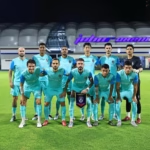Maintaining high-intensity football across an entire season is one of the toughest challenges, especially for a club like Negeri Sembilan FC (NSFC) competing in a demanding Super League and domestic cups. To sustain that tempo game after game, the approach must be integrated — blending tactical, physical, mental, and recovery frameworks.
Here’s a professional breakdown of how NSFC can prepare strategically and practically:
⚽ 1. Tactical & Game Model Alignment
Objective: Ensure high intensity is purposeful, not chaotic.
Key Steps:
- Define clear pressing triggers (e.g. when the ball is played backward, when opponents receive with back to goal).
- Shorter distances between lines — compact vertical spacing (25–30m) reduces running load but maintains intensity through collective movement.
- Rotational pressing roles — avoid over-reliance on wingers or forwards; midfielders must join in pressing cycles.
- Train transitions deliberately — high-intensity teams are built on rapid recovery and counter-pressing. Sessions should include 4v4+4 or 6v6 transition games (8–12s duration, 90% HR max).
🏃♂️ 2. Periodised Physical Conditioning
Objective: Build and maintain aerobic + anaerobic capacity specific to positional demands.
Approach:
- Pre-season: Focus on building aerobic base + repeated sprint ability (RSA).
- In-season: Maintain sharpness with micro-dosed high-intensity intervals (HIIT) twice weekly (e.g., 4x4min at 90% HRmax with 3-min recovery).
- Position-specific conditioning:
- Full-backs/wingers → repeated sprints 20–40m
- Midfielders → small-sided endurance games (high volume, short rest)
- Centre-backs → acceleration + deceleration drills
Monitoring tools: GPS data, heart-rate variability (HRV), wellness questionnaires before each session.
🍽️ 3. Nutrition & Hydration Discipline
Objective: Optimize energy systems and recovery efficiency.
Essentials:
- Pre-match: 3:1 ratio of carbs to protein, low fat.
- During game: Electrolyte gels every 30–35 mins in heat.
- Post-match: Recovery meal within 30 mins — 20–25g protein, 1.2g/kg carbs.
- Hydration protocol: urine color chart + body mass loss <2%.
(Example: Hydration station at STAR Paroi can include sodium–potassium mix bottles for each player, customized via sweat tests.)
🧠 4. Mental Conditioning & Focus Management
Objective: Sustain motivation and concentration under fatigue.
Strategies:
- Visualization sessions: players rehearse high-pressing triggers mentally before matchdays.
- Cognitive drills: reaction-based games (Fitlight, NeuroTracker) to simulate high-tempo decision-making.
- Team rhythm anchoring: leadership group (captain, senior players) to maintain collective emotional balance during pressure phases.
💆♂️ 5. Recovery, Sleep & Load Management
Objective: Prevent fatigue accumulation and reduce injury risk.
Routine:
- 48-hour recovery cycle: contrast baths, compression garments, sleep ≥8 hours.
- Cold-water immersion: 10–12°C for 8–10 mins post-match.
- Sleep tracking: use wearable monitoring to ensure sleep quality (REM, deep cycles).
- Squad rotation: especially for wing positions and box-to-box midfielders who show highest high-intensity distance per 90 mins.
📊 6. Data & Sports Science Integration
Objective: Turn metrics into decisions.
Metrics to monitor:
- Total distance
- High-speed running (HSR) >19.8 km/h
- Sprint count per 90 mins
- Recovery heart rate
- Wellness & fatigue score (daily self-report)
Decision Framework:
→ If HSR drops by >10% from baseline → adjust load next week
→ If RPE (Rate of Perceived Exertion) >7 for three consecutive sessions → consider deload microcycle
🧩 7. Squad Depth & Rotation Policy
Objective: Maintain intensity through availability, not over-reliance.
Guidelines:
- Rotate 2–3 players per game without destabilizing structure.
- Integrate B-team and U-23 players into matchday squads for fresh energy.
- Tactical flexibility — if intensity drops, use fresh substitutes by 60th minute to maintain tempo.
🔬 Example Weekly Microcycle (for Saturday Match)
| Day | Focus | Load Type | Notes |
|---|---|---|---|
| Mon | Recovery + mobility | Low | Hydrotherapy, yoga, wellness screening |
| Tue | Tactical + endurance | High | 8v8 pressing drills, 4x4min HIIT |
| Wed | Small-sided games + finishing | Moderate | 5v5 transition drills |
| Thu | Tactical rehearsal + set pieces | Moderate | Reduced field size, situational pressing |
| Fri | Activation + video review | Low | 45–60 mins, focus on triggers & spacing |
| Sat | Matchday | Max | Game load |
| Sun | Recovery / optional gym | Low | Light cycling, stretching |
💬 Final Thought
For Negeri Sembilan FC to consistently play high-intensity football:
“It’s not just about running more — it’s about running smarter, together, and with purpose.”



